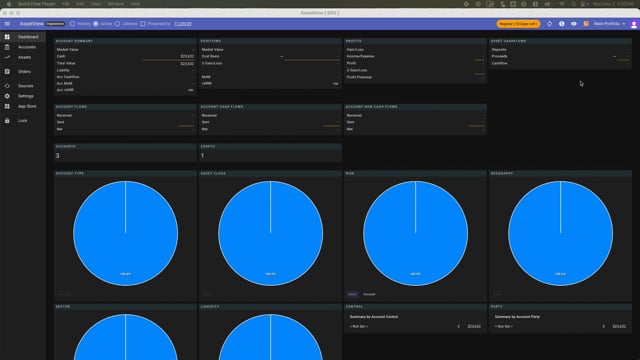Portfolio Management
Video Guide: Manage Portfolios

Overview
In AssetView Central, AssetView's Portfolio management features include creating a portfolio, opening an existing portfolio or a sandbox, restoring a portfolio, and deleting a portfolio.
Open a Portfolio
- In AssetView Central, to open an existing portfolio, click on it.
Create a Portfolio
- In AssetView Central, to create a portfolio, click New Portfolio, choose the portfolio edition, assign a portfolio name, and click create.
- Your new portfolio will open.
Open a Sandbox
- In AssetView Central, you may also open a sandbox. AssetView's Sandbox portfolios come in two flavors.
- The first, the baseline portfolio, shows you how AssetView looks when fully in gear.
- The second flavor sandbox is a blank portfolio so you can try what you have in mind before running it in your active portfolio.
Backup and Restore a Portfolio
- To understand Assetview's restore feature, let's first explore AssetView's backup feature.
- AssetView's portfolio backup feature is automatic.
- If there are any new entries into a portfolio, AssetView automatically backs up your portfolio to AssetView's Cloud each time you open, exit, or lock the portfolio.
- Please note that if you close your browser window without locking or exiting your portfolio, AssetView will still automatically lock your portfolio, but will not create a fresh backup of your data.
- In addition to the automatic backup process, you may manually invoke a backup at any time from within a portfolio in Settings>Data. AssetView keeps the most recent automatic backup and up to 4 additional manual backups, each of which is date and time stamped.
Restore
- In AssetView Central, when restoring a portfolio from a backup, select the portfolio, select the version of the portfolio as denoted by the backup's date and time, and click Restore.
- That portfolio will restore and open.
- The version of a portfolio you choose to restore will become the current working copy of that portfolio.
Delete a Portfolio
- You may delete a portfolio from within AssetView Central or from within that portfolio.
- Deletion of a portfolio has 2 layers of protection to ensure you do not accidentally delete a portfolio.
- From within a portfolio, in Settings>Data, the Disable Deletion checkbox, when checked, prevents accidental deletion.
- You may check or uncheck the checkbox at any time.
- It must be unchecked to delete the portfolio.
- You will also be prompted to confirm with a code.
- You may copy the code provided into the blank box.
- Clicking Accept will delete the portfolio.
Switch Portfolios
- From within a portfolio, click the drop-down menu on the top right to see a list of your portfolios.
- Selecting a portfolio will open that portfolio and close the one that you are navigating away from.
Rename a Portfolio
- From within a portfolio, in Settings>General, you can rename your portfolio.
Share a Portfolio
- You may choose to share access to a portfolio with another current AssetView user.
- The sharing function is accessible from either AssetView Central or from within a portfolio in Settings>Sharing.
- Each portfolio may have multiple Read-only users and one ReadWrite user. In the email box, enter the email address of the user that you are going to share with.
- The email address must be the same one that the user employs to sign into AssetView.
- When you send the share message, and the share will show as pending. When the other user signs in to their AssetView account, in AssetView Central>User>Inbox, they will have a message offering the share, which they may accept.
- The share is then pending a final security step; you must open the portfolio to complete the share.
- You will then see the portfolio as shared, and the other user will then have read-only access.
- Although the read-only user may enter temporary edits to the their Read-only version of the portfolio, those edits are overwritten by the ReadWrite user's portfolio whenever the ReadWrite user opens or exits the portfolio.
